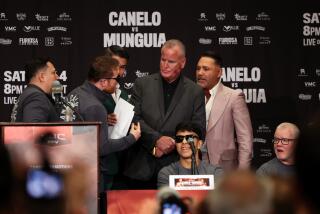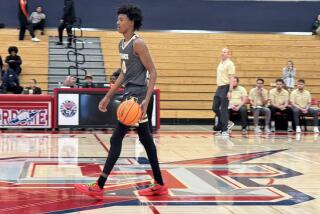Style Points
- Share via
Shane Mosley beat Oscar De La Hoya twice, if you count one fight when they were kids. Vernon Forrest beat Mosley twice, three times if you count the time they fought as amateurs. Ricardo Mayorga beat Forrest twice.
So Mayorga is the most super of the super-welterweights.
Or not.
Ask most boxing experts, they’ll tell you De La Hoya would beat Mayorga. De La Hoya feasts on guys like Mayorga, the raging bulls who come straight at him with no regard for what’s going to stare back at them from the mirror in the morning. Guys like Julio Cesar Chavez and Arturo Gatti, and even Fernando Vargas, who knows better but still led with his jaw against De La Hoya.
Unfortunately for De La Hoya, he’s not fighting Mayorga on Saturday night at the MGM Grand in Las Vegas.
De La Hoya is fighting Mosley again.
You want to know what kind of easy marks bet on boxing? When this fight went on the board, you had to lay down $240 on De La Hoya to make $100. He revealed that his left hand, his money hand, was hurt again, and the next day you had to lay down $250 on De La Hoya to make $100. The gamblers liked him even more.
They must not remember what happened at Staples Center in June 2000, when Mosley won a split decision that not even De La Hoya disputes.
You’re not wrong if you believe De La Hoya will avenge his loss to Mosley. But you are wrong if you believe it will be as easy as the marks seem to think. You’re also wrong if you believe Mosley’s losses to Forrest have any significance in this fight.
Veteran trainer Angelo Dundee said by phone last week from his home in South Florida that Mosley would beat De La Hoya.
“The only thing that’s changed since last time is that Mosley has lost a couple of times to Vernon Forrest,” Dundee said. “But Mosley doesn’t match up against Forrest. He matches up against De La Hoya.”
I had an idea where Dundee was going next. It’s the oldest cliche in boxing, having stood the test of time.
“Styles make fights,” he said.
*
There’s no one more knowledgeable on that subject than Dundee.
First of all, the boxer credited with first declaring that styles make fights was another Dundee, which is no coincidence. Johnny Dundee was a lightweight champion who fought 330 times between 1910 and 1932. He was best known for introducing “The Scotch Woop,” bouncing off the ropes before pouncing to give his punch more power. It could be a problem for Dundee, though, when his opponent punched first.
Angelo Merina Jr. became Angelo Dundee after his older brother, Joe, had changed his last name as a tribute to Johnny Dundee.
Years later, Angelo Dundee was involved in the best example of a style making a fight, or fights, when he trained Muhammad Ali for his three bouts with Ken Norton.
They were neither Ali’s nor Dundee’s finest hours because they never learned how to cope with Norton, who fought with his legs wide apart, his defense almost crab-like.
“I called him Hopalong Cassidy,” Dundee said of Norton. “He’d hop in and throw a punch and then hop right back out. He couldn’t take a big punch. [George] Foreman and [Earnie] Shavers had no trouble knocking him out. But if you didn’t have a great knockout punch, which Muhammad didn’t, he was hard to score against.”
Norton won the first fight in 1973 as a 7-1 underdog, breaking Ali’s jaw. Dundee recalled going to the hospital and hearing Ali, through clenched teeth because his jaw was wired shut, whisper, “We’ll get him.”
They never really did. Ali won the next two fights on decisions, but both were close. Many who saw the third fight insist Norton was robbed.
“He wasn’t the best guy Muhammad faced, but he was the hardest for him to fight,” Dundee said.
Dundee, in a finer moment, was on the other side when he trained Carmen Basilio against Sugar Ray Robinson. Robinson might have been the best pound-for-pound fighter ever, but he couldn’t handle Basilio, the Mayorga of his day.
*
OK, so that wasn’t entirely a style issue.
But then, it seldom is entirely a style issue.
Robinson had difficulties with other fighters, such as Gene Fullmer and Randy Turpin, later in his career, which could be explained by those four words, “later in his career.” A middleweight by then, Robinson wasn’t as dominating against fighters in that division as he had been against welterweights.
Larry Merchant, who used to be one of the best sports columnists around and is now a boxing commentator for HBO, said, “Style matters if it is backed by substance.”
Norton, for instance, was no palooka, winning the heavyweight title a year after his last fight against Ali.
Mosley, for another instance, presents a stylistic challenge to De La Hoya because of quickness. De La Hoya is accustomed to having more hand speed in a fight, but that is not the case when trying to defend against Mosley’s combinations.
That, however, is not the only reason Mosley beat De La Hoya at Staples Center. Mosley is a clever ring general who fights left- or right-handed and adapts well during fights. He and his trainer-father, Jack Mosley, were tactically superior to De La Hoya and his trainer, Roberto Alcazar, who was fired after that fight.
Another point Merchant made was that “style makes fights, but style doesn’t win fights.”
Mosley’s style didn’t win the decisive 12th round against De La Hoya. Mosley’s determination won it.
The winner of this fight, like that one, probably will be determined by who wants it most in the 12th round.
*
(BEGIN TEXT OF INFOBOX)
DE LA HOYA vs. MOSLEY I
*--* In the first fight between Shane Mosley and Oscar De La Hoya, Mosley scored a 12-round split decision on June 17, 2000, at Staples Center. A look at the final punch stats from that fight: De La Hoya Category Mosley 257/718 Total punches 284/678 36% % Landed 42% 92/270 Jabs 110/374 34% % Landed 29% 165/448 Power Punches 174/304 37% % Landed 57%
*--*
Randy Harvey can be reached at [email protected].
More to Read
Go beyond the scoreboard
Get the latest on L.A.'s teams in the daily Sports Report newsletter.
You may occasionally receive promotional content from the Los Angeles Times.










